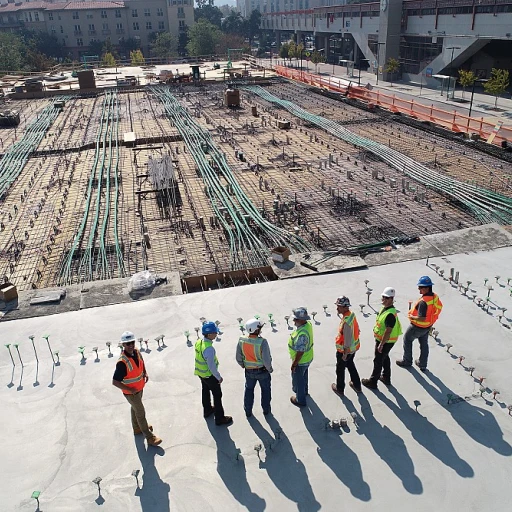The Rise of Automation in Business
The Evolution of Automated Solutions in Today’s Business Landscape
Automation is no longer a futuristic concept or solely the realm of science fiction. It’s a driving force reshaping industries and redefining the way we conduct business. The evolution of automated solutions is marked by rapid technological advances that are making it increasingly accessible and vital for businesses striving for competitive advantage.
The rise of automation is largely fueled by the integration of artificial intelligence and machine learning into everyday business processes. These technologies enable machines to perform tasks that traditionally required human intelligence, such as data analysis, decision-making, and even customer interactions. Companies are adopting automation solutions not only to streamline operations but to increase productivity and efficiency across various departments.
Furthermore, the shift towards automation can be seen as a response to the ever-increasing demand for faster and more reliable services. As businesses aim to meet consumer expectations for instantaneous results, the role of automation becomes indispensable. Automation software facilitates quicker turnaround times, minimizes human error, and ultimately creates a smoother workflow within organizations.
To truly understand the scope of this transformation, it's essential to explore how automation is poised to enhance customer experiences by providing more personalized services. As we delve deeper into this topic, the next section will highlight how automation software contributes to saving time for businesses—an aspect crucial for decision-makers looking to implement these tools effectively. Additionally, exploring the
future of job automation can provide insights into how roles are evolving in the face of these technological advancements.
Automation is not just a trend; it’s a new era of business functionality that transforms how companies interact with their clientele and manage internal processes. As we continue to embrace these changes, the potential for innovation in various industries appears boundless.
How Automation Software Saves Time
Efficiency and Precision
One of the primary reasons businesses across industries are turning to automation software is its remarkable ability to save time, enhancing both efficiency and precision in everyday operations. In the fast-paced world of modern business, time is an invaluable asset, and any solution that helps streamline processes without compromising quality is worth considering. Automation comes to the rescue by performing repetitive tasks and reducing human error, thereby allowing the workforce to focus on more strategic, value-added activities.
Consider the handling of data entry and billing in a company. Manually processing heaps of data can be both time-consuming and prone to mistakes. Automation software can take over these tasks, processing data faster and more accurately, resulting in reduced processing times and lower operational costs. When employees are freed from the monotony of these repetitive tasks, they can channel their efforts into more creative or higher-level thinking projects, adding strategic value to the company.
Moreover, automation can help in maintaining consistency across different branches or departments. Imagine a retailer with franchises across the globe that needs consistent inventory management. Automation ensures uniformity and updates stock levels instantly across all locations, preventing discrepancies and ensuring the right products are always available to the customers.
For more insights into how automation is revolutionizing various aspects of employment and shaping its future, explore
how automation is shaping the future of employment, which delves deeper into this transformative trend.
Automation software tools aren't solely confined to operational efficiency; they extend into enhancing the customer experience as well. Stay tuned to learn more about how this technology is becoming integral to elevating customer interactions and satisfaction.
Customer Experience Meets Automation
Elevating Customer Experiences through Automation
As businesses pivot towards adopting more advanced automation solutions, one area seeing significant transformation is customer experience. The integration of automation in customer service is setting new standards for customer engagement and satisfaction, a leap forward from the traditional methods we've touched upon previously.
Customers today expect quick, personalized, and efficient interactions, and automation is making this possible by streamlining processes and reducing response times. Chatbots, for instance, powered by sophisticated AI algorithms, provide instant assistance around the clock, significantly enhancing the way businesses interact with their audiences.
Moreover, customer relationship management (CRM) systems are incorporating automated tools to offer predictive insights and data-driven suggestions. This enables businesses to anticipate customer needs and tailor their services accordingly, which can lead to increased customer loyalty and retention.
In addition, automation allows for seamless integration across various touchpoints, ensuring a cohesive and satisfying customer journey. By minimizing human error and maximizing accuracy, these automated systems are not only reducing the workload for employees but also building trust with customers.
As companies strive to balance efficiency with experience, the role of automation in shaping a memorable customer journey cannot be overstated. For more insights, you can read about how technology is shaping tomorrow's workplace on our blog:
https://www.future-of-work.net/blog/how-technology-is-shaping-tomorrows-workplace.
In essence, by intertwining automation with customer service strategies, companies can not only bolster their operational efficiency but also build lasting relationships with their customers, a trend set to only grow as we look toward the future of work automation.
Intelligent Automation: The Next Frontier
Beyond Automation: The Era of Intelligent Enterprise
As we journey deeper into the age of automation, businesses are starting to realize the immense potential of transcending beyond typical automated processes and embracing a more intelligent approach. Intelligent automation isn't merely executing repetitive tasks with minimal human intervention; instead, it leverages the latest in artificial intelligence (AI) and machine learning (ML) to elevate traditional automation.
Distinguishing itself with the ability to learn, adapt, and improve through experience, intelligent automation is instrumental in driving operational efficiency and innovation. It allows organizations to tap into predictive analytics, offering insights that were previously unattainable. This transition is not only enhancing how tasks are performed but also influencing decisions, strategy, and the overall growth trajectory of a company.
The transformative impact of intelligent automation is already being witnessed across various sectors. In healthcare, for instance, AI-powered diagnostics are improving patient outcomes by providing more accurate readings and recommendations. Similarly, in the financial sector, intelligent process automation is redefining risk assessment, ensuring more reliable data-driven decisions.
The concept of intelligent automation is closely tied to the notion that machines are not just tools for labor but partners in innovation. When synergized with human creativity and strategic thinking, this advanced automation can propel businesses to new heights. While automation software saves time by automating mundane processes, as discussed earlier, intelligent automation takes it further by adding layers of insight and sophistication.
This frontier is not without its challenges, however. Organizations must navigate complexities such as the integration of AI technologies, data privacy concerns, and the ethical implications surrounding machine decision-making. Yet, for those who can successfully harness the power of this intelligent wave, the rewards promise to be substantial.
Looking ahead, the convergence of AI and automation signals a paradigm shift where enterprises not only become smarter in functionality but can also reposition themselves as learning entities in a rapidly evolving digital ecosystem. It is a stepping stone towards a more adaptive, insightful, and, ultimately, more intelligent world of work.
Case Studies: Success Stories in Automation
Examples of Successful Automation in Various Industries
In today's competitive business landscape, leveraging work automation is no longer optional, but essential. Many companies across various industries have already reaped significant rewards by integrating automation into their operations. Let's delve into some illuminating case studies that demonstrate the potential of automation to transform business processes and deliver exceptional results.
One standout example is a major financial services company that implemented robotic process automation (RPA) to streamline its back-office operations. By automating repetitive tasks like data entry and customer account management, the company reported a 30% reduction in operational costs and a significant improvement in accuracy and processing speed. This not only saved valuable employee time but also improved service delivery, enhancing the overall customer experience.
In the realm of manufacturing, a leading automotive company applied automation to its assembly line processes, incorporating cutting-edge intelligent automation technologies. The integration of AI-powered robots resulted in a 40% increase in production efficiency, alongside a marked reduction in human error during the manufacturing process. This highlights how intelligent automation is stepping in to handle more complex tasks, opening up new possibilities for innovation and efficiency in industries traditionally reliant on manual processes.
Retail is another sector that has embraced automation with open arms. A prominent global retailer has used automation to enhance inventory management and customer service. By deploying automated systems for restocking and utilizing chatbots for customer interaction, the retailer was able to optimize its supply chain and provide customers with faster, more personalized responses. The implementation of automation has become a game-changer, simplifying operations and enriching the customer experience without neglecting the personal touch that consumers expect.
These success stories illustrate the transformative power of automation across diverse sectors. If we consider these examples within the larger context of the blog series, it becomes clear that automation is not just a trend but a crucial element of modern business strategy. From saving time and costs to redefining customer interactions, automation offers numerous advantages that businesses must harness to stay ahead in the ever-evolving marketplace.
As we explore the future of work, understanding the relationship between automation and employment becomes critical. By embracing automation, businesses can create new opportunities for growth and improvement while also addressing job roles and skills of the future.
The Future of Work: Automation and Jobs
Balancing Automation and Employment
In an era where automation technology continues to redefine the workplace, the question of job security looms large for many employees around the globe. The prevailing concern is whether machines will replace humans in the workforce, leading to widespread job loss. However, a more nuanced understanding reveals that the future workforce may not be about displacement but rather about transformation.
Historically, automation has not led to the wholesale disappearance of jobs. Instead, it has shifted the nature of employment. As explored in earlier sections, automation software has taken over repetitive and time-consuming tasks, allowing employees to focus on more strategic and creative aspects of their work. This shift can potentially open new avenues for job creation as businesses are prompted to hire professionals with skills in managing and enhancing these automated systems.
Adapting Skillsets for a New Era
The integration of intelligent automation into the workplace introduces a demand for a versatile skillset. Workers need to pivot towards roles that emphasize creativity, empathy, and complex problem-solving—skills that machines, as sophisticated as they may become, cannot replicate. This transition requires a rethinking of education and professional training to equip the workforce with the necessary skills to thrive alongside automation.
Companies and educational institutions must collaborate to create upskilling and reskilling programs that align with the evolving job market. By investing in continuous learning, individuals can position themselves as valuable assets in a technology-enhanced work environment, rather than competitors to automation technologies.
The Human Touch in an Automated World
Importantly, customer experience, as highlighted in previous discussions, is an area where automation and human skills synergize effectively. While automated systems can handle data processing and routine inquiries, the human touch remains indispensable in creating meaningful interactions and building customer relationships. As automation frees up time, employees can focus on adding value through personalized service and innovative solutions that enhance customer satisfaction.
Ultimately, the future of work with automation is not a binary of humans versus machines. It is about creating a collaborative ecosystem where each complements the other, leading to a more efficient, innovative, and human-centric workplace. The journey towards a seamlessly integrated automated workforce will require careful consideration of the social, economic, and ethical implications, but with strategic planning, it promises to usher in an era of prosperity and innovation.














